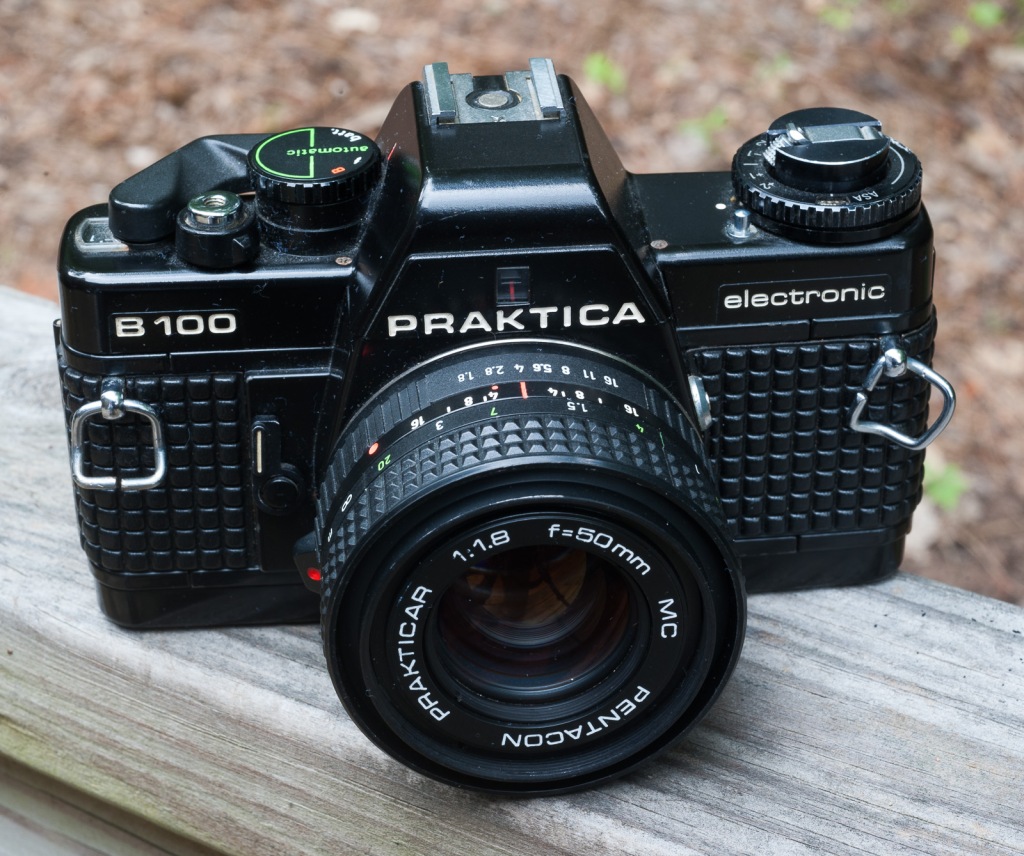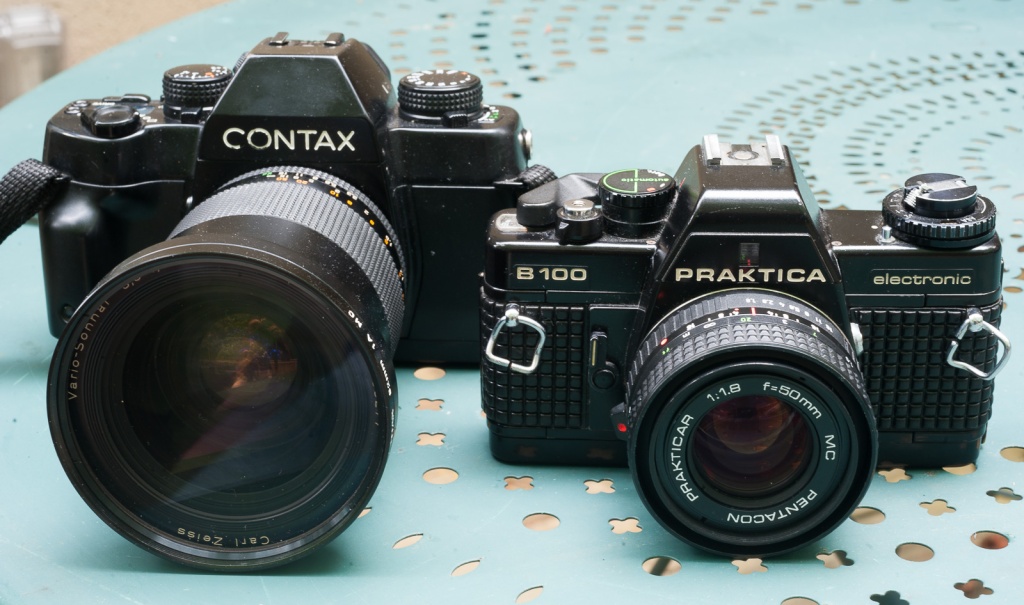Not really. Even if the Praktica B100 (and its lenses) may have been manufactured – at least in part – at locations where Zeiss used to assemble Contax cameras before WWII.

After having spent my hard earned cash on a Contax ST and its impressive Carl-Zeiss Vario-Sonnar 28-85 lens (both manufactured in Japan by Kyocera in the early nineties), I was curious to see what a camera proudly wearing (on the Eastern Block markets) the “Carl-Zeiss Jena” logo was really capable of. I found a very nice/very clean Praktica B100 on the site of Goodwill, and bought it for price of a few lattes at Starbucks.
So, back to Contax, Zeiss, Pentacon and Praktica….
But the truth is that apart from their geographical origin, those Prakticas had very little in common with pre-war Contax cameras, or with the Contax S sold just after the end of WWII – Praktica cameras owed more to designs created originally by another firm from Dresden, K.W (Kamera-Werkstätten Guthe & Thorsch), than to Carl Zeiss’ blueprints.
Although they did not have the right to use the Zeiss and Contax names on the export markets of the West, the East-Germans still tried to associate their line of 35mm SLRs with those prestigious brands: the Praktica cameras sold in the Eastern block wore Carl Zeiss-Jena logos at visible places (as did some of the lenses they were exporting to Western Europe).
The story of Zeiss is as complex and dramatic as Germany’s.
Founded in Jena, and located primarily in the Dresden area, the original Zeiss company suffered from massive aerial bombing during WWII, and from political circumstances in the aftermath of the war. First occupied by the US armed forces, but ultimately located in the Soviet occupation zone, it saw most of its leadership relocated to its Stuttgart offices by the Americans, while the Russians were literally disassembling what was left of its plants and moving them crate by crate to Kiev (Ukraine) as war reparations.

Lengthy legal disputes with the newly formed West German Carl Zeiss AG led the East German Zeiss entity to lose the use of its own name and brands on the Western markets. Under communist management, the East German Zeiss was progressively diluted into a huge state owned conglomerate named Pentacon, which found itself – at least in the West – relegated to the market of simple and affordable SLRs. Sold under the brand “Praktica”, they were more elaborate than the very rustic Russian Zenit, but increasingly behind the Japanese competition.
In 1979, Praktica finally launched a modern automatic SLR with a bayonet mount, the B200, whose derivatives would be manufactured and sold well after the fall of the Berlin wall.
When the communist regime finally fell and West Germany absorbed its East German counterpart, some divisions of the East German optical industry were reunited with Carl Zeiss AG, but not the Praktica line of business – it had been deemed non-competitive in a capitalist market economy. Production continued on a much smaller scale under the control of another German company, Schneider, until the film SLR activity was ultimately terminated in the early 2000s.
The Praktica B line
At least in the West, Praktica was primarily known for a line a semi-automatic SLRs using the Universal 42mm lens mount (such as the Cavalier shown above), but by the mid seventies, even in the entry-level/learners camera market, the screw mount was becoming a handicap.

The B200 was the first model of a totally new line of cameras and lenses, and was followed by simplified and cheaper models such as this B100 manufactured in East Germany in 1981 or 1982. The lens (a 50mm f/1.8) was sold as a “Pentacon Prakticar” in the West, while models destined to markets of the Eastern block were labeled “Carl-Zeiss Jena”. Interestingly, my B100 makes no mention of its East German origin, or of the “Zeiss” brand. Not on the body, not on the lens.
What is it like?
With a new battery (a 6 volt 28A cell that you can find in every pharmacy or drugstore), the camera sprang to life immediately. Honestly, I did not expect it (considering previous experiences with Shopgoodwill, and the reputation for questionable reliability of the electronic components designed in the eighties, in particular on the Eastern side of the Iron Curtain). The camera and the lens look solid and are well finished – the camera is still mostly made of metal, while the lens is made of a nice plastic (with a lens mount machined from a metal alloy).

On paper, the B100 is competing in the same category as the Nikon EM or the Canon AL-1 – namely a simplified Aperture Priority automatic exposure and manual focus camera, providing no direct control of the shutter speed to the photographer (no semi-auto or manual exposure modes). The shutter speed selected by the automatic exposure system is indicated by a needle in the viewfinder, but there is no auto exposure lock or even a simple exposure compensation mechanism (like the +2EV push button of many of those simplified Japanese cameras) – the photographer has to use exposure compensation dial (which equates to playing with the film sensitivity). There is no depth of field preview either.

The viewfinder is very decent – large enough, with a fine and relatively luminous focusing screen. Focusing aids include a split image telemeter, surrounded by a ring of microprisms. No reason to complain.
The bayonet lens mount is proprietary. Prime lenses were made in East Germany (a 28mm, a 35mm, a couple of 50mm lenses, a 80mm and a 135mm), and two zoom lenses were sourced from Japan (probably from Sigma): a sliding aperture 35-70, and a sliding aperture 70-210mm. As usual with brands targeting price conscious buyers, wide angle and tele lenses did not sell in large quantities. They tend to be difficult to find nowadays and are comparatively expensive.
How much…buying a Practice B series now…
I still have to shoot a few rolls of film with the camera, but upon a cursory inspection it looks fine (reasonably accurate exposure, light seals in good condition). It’s not the camera I would bring for a trip to the end of the world: it does not offer enough control over the exposure, and I remember that back in the eighties, the B series’ reputation was abysmal when it came to reliability. But the truth is that its perceived quality is much higher than some entry level cameras from the same era (Fuji AX Multi or STX-2 for instance). All in all a pleasant surprise.

The Praktica B series were manufactured from 1979 to 1990, before being superseded by the BX series – which were sold until 2001. The BX were still manual focus cameras (of course) but their internals had been updated, and the industrial design refreshed with more curves and bulges, and much more polycarbonate. The BX cameras were sold in much smaller quantities than the B series (200,000 units before the German re-unification, and 33,000 in the 10 following years, as opposed to 1.1 million over 11 years for the B series).

This relative scarcity could explain why some late BX series (in particular those with green colored bodies) are so expensive: they are sometimes proposed for more than $1,000 on auction sites. On the other hand, early B series (like the B100 or the B200) can still be found for less than $25.00, which is in line with the price of other amateur/entry-level SLRs from the same vintage.
If you’re really interested in one of those “almost a Contax” cameras, you don’t need to spend much – unless you’re willing to pay to the roof for the privilege of shooting film with the only “made in [re-unified, non-communist] Germany” single lens reflex which is not a Leica R.

More about Praktica cameras
http://praktica.planetaclix.pt
http://www.praktica-collector.de/225_Praktica_B100.htm
Sorry, no picture shot with the Praktica yet – but 2 pictures shot in Paris with another made in Japan (West) German camera , the Leica CL:

